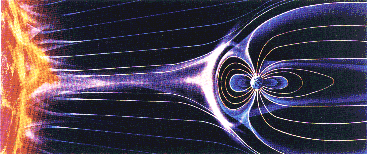Go to links.
.
Ever since the launch of the first Sputnik in 1957, space exploration has
advanced on two fronts, manned and unmanned. The manned missions are well known--from Mercury, Gemini and Apollo, to the Space Shuttle and the proposed Space Station Freedom. Millions have watched "Apollo 13" or "The Right Stuff."
In contrast, the exploration of space by unmanned spacecraft has remained
almost invisible. The world applauded in 1958, when Explorers 1 and 3
discovered the radiation belt, but the many missions which followed are virtually unknown.
Here is a glimpse of that other side of the space adventure. It includes:
- The magnetosphere, the region dominated by the Earth's magnetic field. Here energetic particles are trapped and fast electrons are produced; some are sent down into the atmosphere to produce the polar aurora or "northern and southern lights." Unmanned probes also discovered magnetospheres around Jupiter, Saturn, Uranus and Neptune.
- The fast solar wind, flowing out of the Sun in all directions, hemming in the Earth's magnetosphere while supplying energy to the aurora and to other geospace phenomena.
- The many types of high energy particles found in space, produced near Earth, at the Sun and in distant stars. The universe seems surprisingly rich in such particles, and we are only beginning to understand why.
- The complex flow of plasmas in space, of gases consisting of free electrons and of electrically charged atoms missing one or more electrons ("ions"). Most of the known universe consists of plasma, and the magnetosphere is our best laboratory for studying its plasma processes.
"The Exploration of the Earth's Magnetosphere" is meant to give you, the reader and browser, a brief tour of this strange and fascinating new world. It assumes no prior knowledge and uses no mathematics, though it does require close attention. It includes a quick overview of the relevant physical sciences--magnetism, ions and electrons, plasmas etc.--and also includes tidbits of history, accessible by a "history button" at the ends of many sections. You can access any file directly through the index, or else cover them sequentially, guided by the summary files below:
You can also link to a list of additional resources and web links, and the "history button" below brings up a chronology of magnetospheric exploration.
Have fun!
|


 Official GSFC Home Page .........
Official GSFC Home Page .........
 NASA WWW Home Page
NASA WWW Home Page